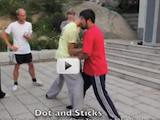Today, Master Chen corrected the following students’ partial yilu:
- Karen Mattox
- Gerry Gebhart
- Albert Chung
Single Whip
Master Chen used the foot shovelling out in single whip as an example to talk about the concept of using a stick to pry open something. We shove the stick into a crack, then the front end of the stick cannot move anymore and stays in the same place. We can then make the crack bigger by prying with the stick. The key is that the one of the stick is not moving. As we pry, we may meet resistence, we can add a longitudinal rotation as we pry, it will allow the stick to go over the resistence. Regarding the single whip, we want to make sure that the toes do not point up as we shovel so that we can apply the longitudinal rotation on the entire left leg. As we shovel the left foot, the weight must stay on the right foot. As we shift over to half horse stance, the longitudinal rotation on the left leg occurs at the same time.
Initial Closing
Lock the arms. Use the front kua as the non-moving dot. Rear foot steps back to create a stretch to pull the front (arms and kua).
Second Closing
Right after fetch water. Lock the front hand and rear elbow. Treat that line as stick. Decide on a point that this stick needs to go under in the move. This designated point can become lower to increase difficulty of the move, e.g. using the front knee as that point.
Right Turn Buddha’s Warrior Attendant Pound Mortar
Exercise: “Chest, Kua, Up and Down”
- Use the chest to cause the edge of hands (7-inch blade) to go out and create a hit.
- Tie the bottom of the inner right forearm near the elbow to the right kua. As the right kua goes down, it carries the elbow to go down with it.
- Imagine a top-down force is on the right bicep and we can’t just lift the arm, we must use the right foot to shoot a force up to the right shoulder to carry the right arm to go up with it.
The above describes a 3-part positive circle for the right arm. Step 1 is a horizontal move, step 2 and 3 are vertical moves, so the entire circle does not stay in one dimension. In general, the hand and elbow are responsible for the horizontal movement, while the kua and foot are responsible for the vertical movement.



{ 1 comment… read it below or add one }
Thank you for such a detailed note! This is awesome.